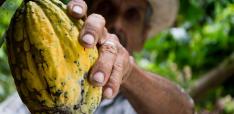Child Trafficking - Profiting from Vulnerability

Loria-Mae Heywood draws attention to the market forces at play in the trafficking and exploitation of children, and provides examples of good practices from Europe, Africa and Asia in support of the protection of children against trafficking. She then champions the use of systemic and collaborative approaches, along with ethical practices to support the fight against child trafficking.
This is part of a forthcoming Global Policy e-book on modern slavery. Contributions from leading experts highlighting practical and theoretical issues surrounding the persistence of slavery, human trafficking and forced labour will be serialised here over the coming months.
In every society, be it ‘developed’ or ‘developing’, there will always be vulnerable children, the degree and extent of the vulnerabilities faced by such children differing within and across countries and communities. The circumstances and dispositions that contribute to, and facilitate the vulnerability of children could have a basis in a number of factors including, but not limited to, inadequate economic resources and financial alternatives, a lack of maturity of mind, weak guardianship systems, and inadequate societal exposure.
What is both disconcerting and repugnant is that traffickers have capitalised on such vulnerability factors, targeting boys and girls for their organs, and for the provision of labour, sexual, and other services. That children should be recruited, transported, transferred, harboured and/or received for the purpose of being exploited – the conception of child trafficking based on the UN Trafficking Protocol – speaks not only to the intentionality and criminality involved in trafficking; it also speaks to the bleak prospects that exist for the children whose human rights and dignity would be undermined at the hands of traffickers and at the hands of those who demand and use their bodies, labour, produce, and services for their benefit and pleasure.
Preventing the exploitation of children by addressing factors and practices which enable and facilitate the vulnerability of children is therefore an absolute imperative if children are to be saved the harrowing journeys and experiences that leave them traumatised, abused, and even dead. Focus will therefore be given to some of the strategies that have been used in an attempt to fight child trafficking, and correspondingly facilitate the protection of children. Prior to this focus, insight will be provided into the human trafficking industry – its estimated value, supply and demand factors that fuel this industry, and the children who have been detected and exploited as a consequence of this industry.
A billion-dollar industry
The trafficking in human beings, under which child trafficking is subsumed, is a billion-dollar industry. The specific profits derived from the exploitation of human beings, via trafficking, are not known due to the clandestine nature of trafficking. Nevertheless, it is estimated that the profits generated from forced labour (which includes but is not limited to labour derived from trafficking) amount to US$150 billion per year (ILO, 2014). This estimate is said to be a reflection of both the ILO’s use of an updated methodology from what was used in 2005 to determine the profits derived from the use of forced labour, and the use of data collected for the ILO’s 2012 Global Estimate of Forced Labour. It should be noted that profits generated from state-imposed forced labour are not covered in the 2014 and 2005 estimates. Asia, and Developed Economies are said to be the top sources of profits, with sexual exploitation gaining the highest level of profits of the respective sectors of exploitation. In 2005, economist Patrick Belser, via an ILO Working Paper, estimated that the yearly profits generated from forced labour was US$44 billion – a figure which includes the US$32 billion in profits which the ILO, in 2005, estimated was generated per year by trafficked forced labourers. Most victims were trafficked for commercial sexual exploitation, followed by economic exploitation and mixed forms of exploitation. Further, industrialized countries accounted for half of the profits, while almost one-third of the profits was derived from Asia.
Susceptible to the workings of the market, the trafficking of children and the subsequent profits generated from the exploitation of children is fuelled by demand and supply. The excessive reference to ‘traffickers’ in human trafficking debates may lead one to infer that these actors are the main or only stakeholders in trafficking activities, and may even lead to a feeling of disconnect between the crime of trafficking and one’s personal actions. However, the demand and supply of child victims is fuelled by a number of actors who all contribute, wittingly or unwittingly, to the trafficking and exploitation of children.
On the demand side, employers and business owners, consumers and clients, and third parties such as recruiters and agents all contribute to the perpetuation of the child trafficking industry. For example, the loyal customer who buys beautiful sweaters for his family from his favourite local department store may be blissfully unaware that the fingers of those who knitted those sweaters were those of children recruited to work in deplorable factory conditions, and who received a mere pittance for the hours that they slaved over those items of clothing. Should that scenario be true, that customer would have unknowingly contributed to the demand for trafficked and exploited labour. He would also have profited from the vulnerability of children and the lack of adequate safeguards for the ethical sourcing of products within supply chains and webs, as would the businesses that sourced such products.
As a point of reference for the prevalence of goods potentially produced by child labour or forced labour, the Bureau of International Labor Affairs (ILAB) – an operating unit of the United States Department of Labor – revealed that the List of Goods Produced by Child Labor or Forced Labor comprised 155 goods from 77 countries. Based on this 2020 report/list, the agriculture sector has the greatest amount of child labour and forced labour respectively, followed by the manufacturing, mining/quarrying and pornography sectors respectively. The top 3 goods with the most child labour are gold (22 countries), bricks (19 countries) and sugar cane (18 countries), while the top 3 goods with the most forced labour are bricks (9 countries), cotton (8 countries), and garments (7 countries).
But the furthering of the child trafficking industry and the profiting from the exploitation of children is not only due to demand factors but also to the presence of children who are at risk of being exploited. The supply of children to the child trafficking industry is facilitated by personal, socio-economic and cultural factors that make children vulnerable to trafficking, as well as the presence of individuals who are willing to facilitate their exploitation. These individuals have been and could be family members and persons known to the child/children, or they could be strangers. In Nigeria, for example, there exists a cultural practice of informal fostering in which parents or guardians, many times due to economic challenges, arrange for wealthier members of society to take care of their child/ children. In such arrangements, there is usually the expectation that the child would perform household or other tasks for the host family. This informal system of fostering, which has many positive attributes, has however sometimes been misused to facilitate the trafficking of children for domestic servitude, sexual exploitation and other forms of exploitation as host families take advantage of children in their care or as traffickers operate under the guise of arranging for children to be hosted and in turn facilitate their exploitation. Underpinning the vulnerability of children to trafficking and exploitation, in this instance, is the convergence of economic push factors and cultural enablers situated within the social and communal context of Nigeria. While push factors to trafficking differ across countries, it is common (like in this instance) for a combination of vulnerability factors, including the lack of suitable coping mechanisms and alternatives, to create an enabling environment for the trafficking and eventual exploitation of children.
The United Nations Office on Drugs and Crime (UNODC) reports that for the year 2016, of the fifty-four countries examined, children comprised approximately 30 per cent of detected victims, with there being far more girls than boys. Of the 2,350 girls detected, 72 per cent had been trafficked for sexual exploitation, 21 per cent for forced labour and 7 per cent for other purposes. In the case of the 711 boys detected, 50 per cent had been trafficked for forced labour, 27 per cent for sexual exploitation, and 23 per cent for other purposes. The ‘other purposes’ for which children had been trafficked included forced begging, forced marriage, forced criminal activities, and to serve as child soldiers. (See the UNODC’s Global Report on Trafficking in Persons – 2018.)
Trafficking has a human cost and the supply and succumbing of children to the trafficking industry makes it imperative to relentlessly pursue efforts to protect and prevent boys and girls from being trafficked and exploited. The three examples featured below serve the purpose of providing insight into efforts that have been made to fight child trafficking by targeting the protection of children. It is hoped that these revelations will provide inspiration for what could be done to fight child trafficking (adjusted to respective country contexts), as well as reveal that the protection of children against trafficking is of win-win benefit to children on the one hand, and businesses and the society at large on the other hand.
Example 1: The Wrap Around Model – the Netherlands
In the Netherlands, the Wrap Around Model has been used to provide composite and consolidated support to the Roma community in an attempt to tackle the trafficking of Roma children for forced criminal exploitation and forced begging. Implemented by the Dutch National Police in collaboration with government and civil society organisations, this Model (featured within Anti-Slavery International’s Trafficking for Forced Criminal Activities and Begging in Europe: Exploratory Study and Good Practice Examples report) is centred around the presence of individuals and services who/which ‘wrap themselves around’ vulnerable Roma families in an attempt to insulate children from trafficking and exploitation. This Model involves the assigning of a Family Manager to each family that is perceived to be at risk of child abuse and child trafficking. The Family Manager serves as the point of contact and intermediary between the designated family and professional support persons and organisations that are working with the family, be it the school, child protection service, housing association, or the police. This manner of operation and coordinated support has helped to provide vital support to target families, while also helping in the identification and prevention of trafficking and the exploitation of children.

The Wrap Around Model (Source)
Example 2: International Cocoa Initiative – Ghana and Côte d’Ivoire
Extending beyond a focus on child trafficking, the International Cocoa Initiative (ICI) – a Swiss-based foundation operating in Ghana and the Ivory Coast – has been dedicated towards ensuring a better future for children, and advancing the elimination of child labour. Focusing its activities around the cocoa and chocolate industry, it has worked with multiple partners (including farming communities, businesses, unions, civil society groups and national governments in cocoa-producing countries) towards providing greater protection to children and their rights, managing the risk of child labour within the cocoa supply chain, and sharing knowledge and information in an open and transparent manner. Activities and actions performed in favour of the protection of children have included the following: the organisation of community mobilization meetings on the issues of child labour and child trafficking; the implementation of initiatives to reduce the vulnerability of children to child labour and child trafficking, including through school rehabilitation and the recruitment of teachers; and the establishment of Child Labour Monitoring and Remediation Systems which use facilitators within cocoa-growing communities to bring attention to child labour, and request the remediation of respective cases. (For further details on the ICI: Source(a); Source(b))

Cacao pods (Paul George via Flickr)
While trafficking into the cocoa sector and child labour within the cocoa sector have not been eliminated, the work by the ICI has contributed to the protection of children from child trafficking and child labour. Companies that pursue ethical practices and strive to fight against the exploitation of children within supply chains could be said to have greater prospects of good brand and company reputation, and the concomitant provision of support by members of the public. The converse should also be considered.
Example 3 – Peer educators and Socialization Centres – Bangladesh
As featured in the Background paper on Good Practices and Priorities to Combat Sexual Abuse and Exploitation of Children in Bangladesh, one of the strategies that has been employed in Bangladesh to raise awareness on children’s rights issues has been the use of boys and girls to share relevant information with their peers. The Association for Community Development (ACD) in Rajshahi, for example, has provided training to children, who have in turn discussed issues such as trafficking, early marriage, and sexual exploitation with their peers. Such discussions have been facilitated by adult women and adult men who work with the girls and boys respectively. One achievement, as detailed by a group of girls, was the identification of a suspected trafficker, after which the Union Parishad Chairman was informed.
As further seen via one of the child-focused web pages of the ACD, a community-based approach to the prevention and protection of children from trafficking, commercial sexual exploitation, violence, abuse, and vulnerable situations is facilitated through the use of Socialization Centres. Focusing on the development of children and the community through socialization, services provided by Socialization Centres have included counselling, education on self-protection, and library services. Meetings have also been held with parents and other groups, with focus being given to mainstreaming out-of-school children and identifying children at risk. Other services performed through the Centres have included the following: parenting education sessions on issues such as understanding childhood and development; awareness-raising sessions on the protection of children at the level of the community and society, respectively; and the provision of vocational training to adolescent boys and girls from “untouchable, city slum and indigenous communities”. What is notable is that the voices of children have also been integrated into community-based approaches; children have been used in local-level advocacy so that the community-based governance structure could be more child-sensitive and proactive. The initiatives by the ACD have been said to increase individual and community participation in reducing, inter alia, child marriage, sexual abuse, child labour, trafficking, and discrimination.
Effecting positive change
As contemplation is given to the trafficking and exploitation of children in and from different parts of the globe and the actions that have been directed towards the protection of children, it is evident that only through sustained, individual, collaborative, cross-sectoral, inter-sectoral and sustainable efforts could there be any hope of protecting children from trafficking, and reducing the profitability of the trafficking industry. Such efforts should not be merely directed towards alleviating current realities and influencing consumer habits but should rather be combined with systemic changes.
Awareness-raising, the provision of education and skills training, and the monitoring of supply chains, while important, are surface-oriented strategies. If sustained and sustainable change is to be effected, such efforts need to be combined with the building and strengthening of child protection and social protection systems, the provision of suitable alternatives to those who are at a risk of being trafficked, and the creation, implementation and enforcement of laws that are deemed suitable to support the protection of children and conversely respond to the abuse of children and their rights.
As consumerism is replaced with responsible and ethical consumption, as businesses support and enforce ethical practices, as family systems are strengthened, and as long-term and systemic child protection inputs are made, greater possibilities will exist for the protection of children against trafficking. There is no guarantee that such efforts will result in the transformation of an individual’s character, and in turn increase the value that such an individual attaches to children and their lives. However, the strengthening of child protection and social protection systems and the implementation and enforcement of child protection regulations may, at least, help to curb human deficiencies by facilitating the regulation of conduct.
Loria-Mae Heywood is a researcher, writer, and human and social development advocate whose academic and professional expertise includes work on child protection and child rights, child trafficking, social protection, and human and social development. Her recently published article can be seen as follows: Before Saying “I Do”: Legal and Policy Considerations for Facilitating Clarity on Human Trafficking and the Protection of Children in Albania. She can be contacted via the following address: LoriaMae.Heywood@gmail.com
Photo by lalesh aldarwish from Pexels


